| Great Shohola Train Wreck | |
|---|---|
| Details | |
| Date | July 15, 1864 |
| Location | Shohola Township, Pike County, Pennsylvania, USA |
| Country | United States |
| Operator | Erie Railroad |
| Incident type | Head-on collision |
| Cause | dispatcher error |
| Statistics | |
| Trains | 2 |
| Passengers | 958 |
| Deaths | 60–72 |
The Shohola train wreck occurred on July 15, 1864, during the American Civil War on the broad gauge Erie Railroad 11⁄2 miles (2.4 km) west of Shohola, Pennsylvania. A train carrying Confederate prisoners of war collided head-on with a coal train. Some 65 prisoners, guards, and train crew were killed.
The prisoners were being taken from Point Lookout, Maryland, to newly constructed Camp Rathbun at Elmira, New York. [1] They had begun their journey by steamer, traveling along the Atlantic coast from Maryland to New Jersey. Here they were switched to railroad for the final 273 miles (439 km) to Elmira. [2] Some 833 Confederate prisoners of war (many captured at the Battle of Cold Harbor [3] ) were accompanied by 128 Union guards from the Veteran Reserve Corps. [4]
The prisoners' train, consisting of 18 cars hauled by 30-ton wood-burning Engine 171 [5] was designated as an 'extra', meaning it ran behind a scheduled train which displayed warning flags giving right of way to the following 'extra'. However Engine 171 had been delayed leaving Jersey City until 6 a.m. while guards located missing prisoners and was further delayed en route so that it arrived at Port Jervis, four hours late. [6] The next 23 miles (37 km) of the railroad was, and is, a single track snaking along the Delaware River through hardwood forest, and has many "blind" curves. [3] It passed through Sparrowbush, New York, and was travelling at a speed of 20 to 25 miles per hour (32 to 40 km/h) when it reached Shohola Township in Pennsylvania at 2.50 p.m. Ahead at Lackawaxen the dispatcher was responsible for stopping all eastbound traffic until the 'extra' had passed through. But it had been more than four hours since the scheduled train had passed through that morning and when a coal train from the Hawley branch, bound for Port Jervis, stopped at Lackawaxen Junction with 50 loaded coal cars the dispatcher mistakenly allowed it through. Soon afterwards he received the message that the 'extra' had passed Shohola; but it was too late. [5]
A mile and a half (2.4 km) from Shohola the track passes through "King and Fuller's Cut" which had only 50 feet (15 m) of forward visibility as the track negotiated a series of blind bends. The trains collided head-on with a crash so fierce that it was said that locals 'felt it as an earthquake'. [3] The combined speed was more than 30 mph (48 km/h), and propelled the wood stacked in each engine's tenders forward into the cabs; killing both engineers and firemen. The wooden box cars were telescoped into each other. [2] Of the 37 men in the car immediately behind the engine, 36 were killed outright, the only survivor being thrown clear. Most casualties occurred in the first three box cars, those riding further back escaped death though many were injured. A ring of uninjured guards was formed around the wreck but despite this five Confederate prisoners escaped and were never recaptured. [7] [5] [8] Frank Evans, a Union guard described the scene: "The two locomotives were raised high in the air, face-to-face against each other, like giants grappling...The front (car) of our train was jammed into a space less than six feet. The two cars behind it were almost as badly wrecked. There were bodies impaled on iron rods and splintered beams. Headless trunks were mangled between the telescoped cars"
The citizens of Shohola and nearby Barryville, New York, treated the wounded 'without regard to the colour of their uniforms' [1] and doctors sent by two relief trains from Port Jervis worked throughout the night. [9] The official death toll was 65 people killed composed of 44 prisoners, 17 guards, and 4 railway staff, [5] however estimates range from between 60 and 72. [6] A subsequent enquiry found the dispatcher, who fled the scene, to be negligent. [2]
The dead were buried in unmarked graves next to the track, where they remained for 47 years until 1911 when they were moved to the Woodlawn National Cemetery at Elmira, and the Shohola Monument erected with the names of the Union soldiers on one side and the names of the Confederate soldiers on the other. [2] The Shohola Railroad Historical Society houses a museum dedicated to the wreck in a caboose stationed permanently in Shohola. [3]

The Baltimore and Ohio Railroad was the first common carrier railroad and the oldest railroad in the United States. It operated as B&O from 1830 until 1987, when it was merged into the Chessie System; its lines are today controlled by CSX Transportation.
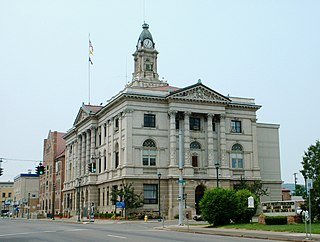
Elmira is a city and the county seat of Chemung County, New York, United States. It is the principal city of the Elmira, New York, metropolitan statistical area, which encompasses Chemung County. The population was 26,523 at the 2020 census, down from 29,200 at the 2010 census, a decline of more than 7 percent.

The Great Locomotive Chase was a military raid that occurred April 12, 1862, in northern Georgia during the American Civil War. Volunteers from the Union Army, led by civilian scout James J. Andrews, commandeered a train, The General, and took it northward toward Chattanooga, Tennessee, doing as much damage as possible to the vital Western and Atlantic Railroad (W&A) line from Atlanta to Chattanooga as they went. They were pursued by Confederate forces at first on foot, and later on a succession of locomotives, including The Texas, for 87 miles (140 km).

The Louisville and Nashville Railroad, commonly called the L&N, was a Class I railroad that operated freight and passenger services in the southeast United States.
A gravity railroad or gravity railway is a railroad on a slope that allows cars carrying minerals or passengers to coast down the slope by the force of gravity alone. The speed of the cars is controlled by a braking mechanism on one or more cars on the train. The cars are then hauled back up the slope using animal power, a locomotive or a stationary engine and a cable, a chain or one or more wide, flat iron bands. A much later example in California used 4 ft 8+1⁄2 instandard gauge steam engines to pull gravity cars back to the summit of Mt. Tamalpais.

The Delaware and Hudson Canal was the first venture of the Delaware and Hudson Canal Company, which would later build the Delaware and Hudson Railway. Between 1828 and 1899, the canal's barges carried anthracite coal from the mines of northeastern Pennsylvania to the Hudson River and thence to market in New York City.
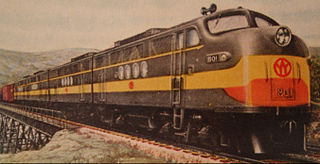
The New York, Ontario and Western Railway, commonly known as the O&W or NYO&W, was a regional railroad founded in 1868. The last train ran from Norwich, New York to Middletown, New York in 1957, after which it was ordered liquidated by a U.S. bankruptcy judge. It was the first notable U.S. railroad with its mainline entirely abandoned.
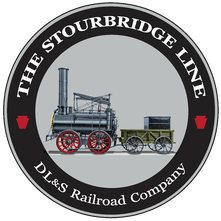
The Stourbridge Line is a shortline railroad that operates 25 miles (40 km) of former Erie Lackawanna Railroad trackage between Honesdale and Lackawaxen, Pennsylvania, where it connects with Norfolk Southern Railway. The line was previously owned by the Lackawaxen-Honesdale Shippers Association and operated under contract by Robey Railroads. The operation was contracted to the Morristown & Erie Railway in January, 2009; service ended in 2011. Service was resumed by the Delaware, Lackawaxen & Stourbridge Railroad (DL&S) on May 9, 2015.

Woodlawn National Cemetery is a United States National Cemetery within Woodlawn Cemetery, which is in the city of Elmira, in Chemung County, New York. Administered by the United States Department of Veterans Affairs, it encompasses 10.5 acres (4.2 ha), and as of 2021, had over 11,000 interred remains.

Barryville is a hamlet in Highland, Sullivan County, New York, United States. Previously known as "The River," the hamlet was renamed for William T. Barry, postmaster general under President Andrew Jackson.

Elmira Prison was originally a barracks for "Camp Rathbun" or "Camp Chemung", a key muster and training point for the Union Army during the American Civil War, between 1861 and 1864. The 30-acre (120,000 m2) site was selected partially due to its proximity to the Erie Railroad and the Northern Central Railway, which crisscrossed in the midst of the city. The Camp fell into disuse as the war progressed, but its "Barracks #3" was converted into a military prison in the summer of 1864. It was the prison holding the largest number of Confederate POWs. Its capacity was 4,000, but it held 12,000 within one month of opening. A different source says that Camp Rathbun had a capacity of 6,000 recruits, but that it was turned into a prison for 10,000 and the Union Commissary General was given just 10 days to make it happen.

McNeill's Rangers was an independent Confederate military force commissioned under the Partisan Ranger Act (1862) by the Confederate Congress during the American Civil War. The 210 man unit was formed from Company E of the 18th Virginia Cavalry and the First Virginia Partisan Rangers. After the repeal of the Act on February 17, 1864, McNeill's Rangers was one of two partisan forces allowed to continue operation, the other being 43rd Battalion Virginia Cavalry. Both of these guerrilla forces operated in the western counties of Virginia and West Virginia. The Rangers were known to exercise military discipline when conducting raids. However, many Union generals considered Captain John Hanson McNeill (1815–1864) and his men to be "bushwhackers," not entitled to protection when captured, as was the case with other prisoners of war.
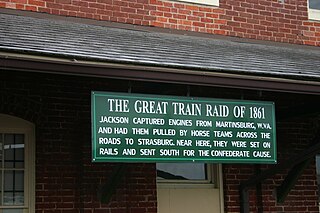
Colonel Stonewall Jackson's operations against the Baltimore and Ohio Railroad in 1861 were aimed at disrupting the critical railroad used heavily by the opposing Union Army as a major supply route. A second goal was to capture the maximum number of locomotives and cars for use in the Confederate States of America. During this point in the war, the state of Maryland's stance was not yet determined. The B&O Railroad, then owned by the state of Maryland, ran through Maryland and along the Potomac River Valley in its pass through the Appalachian Mountains, but took a crucial turn at Harpers Ferry and passed south, through Virginia and Martinsburg while crossing the Shenandoah Valley. The railroad then continued on through much of present-day West Virginia, which then was still part of Virginia, meaning that a major portion of the route went through a state which later seceded.

The Chunky Creek Train Wreck occurred on February 19, 1863, when a train crashed into the creek from a bridge damaged by heavy rain on the Southern Rail Road line between Meridian and Vicksburg, Mississippi.
The Winchester and Potomac Railroad (W&P) was a railroad in the southern United States, which ran from Winchester, Virginia, to Harpers Ferry, West Virginia, on the Potomac River, at a junction with the Baltimore and Ohio Railroad (B&O). It played a key role in early train raids of the B&O during the beginning months of the American Civil War.

Hanover Junction is a small unincorporated community, which is located in south-central York County, Pennsylvania, United States, near the borough of Seven Valleys. The junction serves as a rest stop on the York County Heritage Rail Trail.

The Battle of Vienna, Virginia was a minor engagement between Union and Confederate forces on June 17, 1861, during the early days of the American Civil War.

Ralston is an unincorporated community in McIntyre Township, Lycoming County, Pennsylvania, United States. The community is located along Pennsylvania Route 14, 18.5 miles (29.8 km) north of Williamsport. Ralston has a post office with ZIP code 17763.
The Lackawanna Limited wreck occurred when a Delaware, Lackawanna and Western Railroad (DL&W) passenger train, the New York-Buffalo Lackawanna Limited with 500 passengers, crashed into a freight train on August 30, 1943, killing 29 people in the small Steuben County community of Wayland in upstate New York, approximately 40 miles (64 km) south of Rochester.
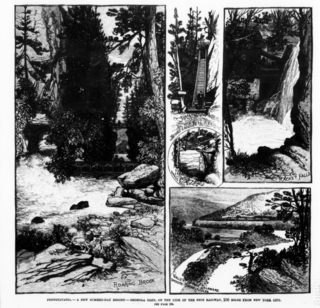
Shohola Glen Amusement Park was an amusement park in Shohola Township, Pennsylvania. It operated from 1884 to 1907. The park's attractions included nature-related draws, and amusements such as a carousel, a skating rink, a boating area, a baseball field, and a dance hall.